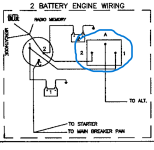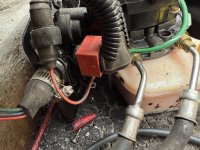Hey All,
I purchased a Chaparral 1930 SS Sport 5.0L last year and while getting it ready for spring I found out that the number 2 battery doesn't power anything when selected. The batteries are fully charged, I replaced the Perko dual battery switch even the old one tests good, the cables are correctly installed and getting continuity and I'm stumped. Battery select 1 and both works just fine but in the number 2 position I get crickets at the ignition switch and no power to anything. I also have a question about something on the wiring diagram that I cannot identify and it's a box labeled "A" with a 1 & 2 in it and then a single wire goes to the alternator. See image below and any help would be greatly appreciated.
I purchased a Chaparral 1930 SS Sport 5.0L last year and while getting it ready for spring I found out that the number 2 battery doesn't power anything when selected. The batteries are fully charged, I replaced the Perko dual battery switch even the old one tests good, the cables are correctly installed and getting continuity and I'm stumped. Battery select 1 and both works just fine but in the number 2 position I get crickets at the ignition switch and no power to anything. I also have a question about something on the wiring diagram that I cannot identify and it's a box labeled "A" with a 1 & 2 in it and then a single wire goes to the alternator. See image below and any help would be greatly appreciated.


